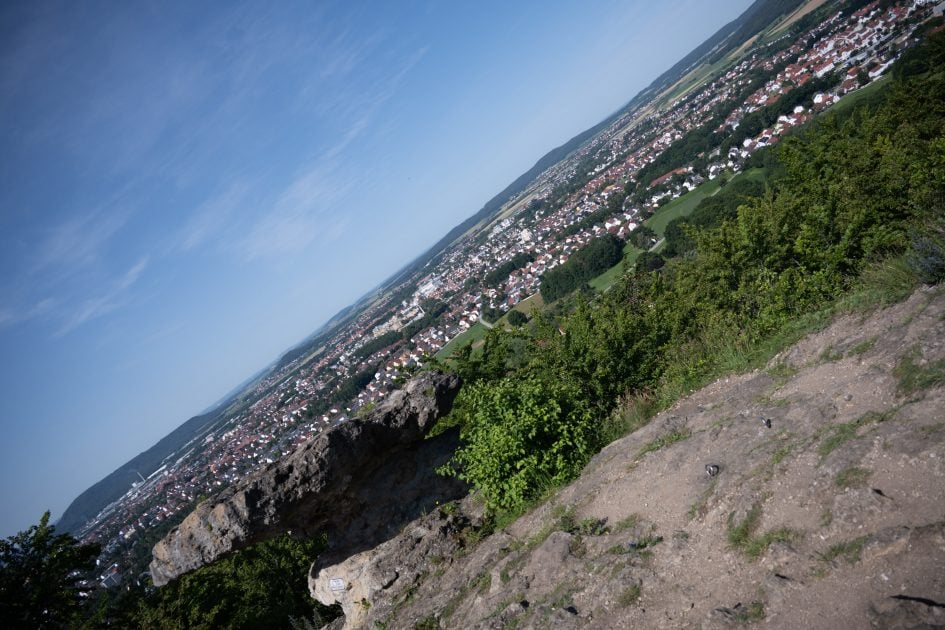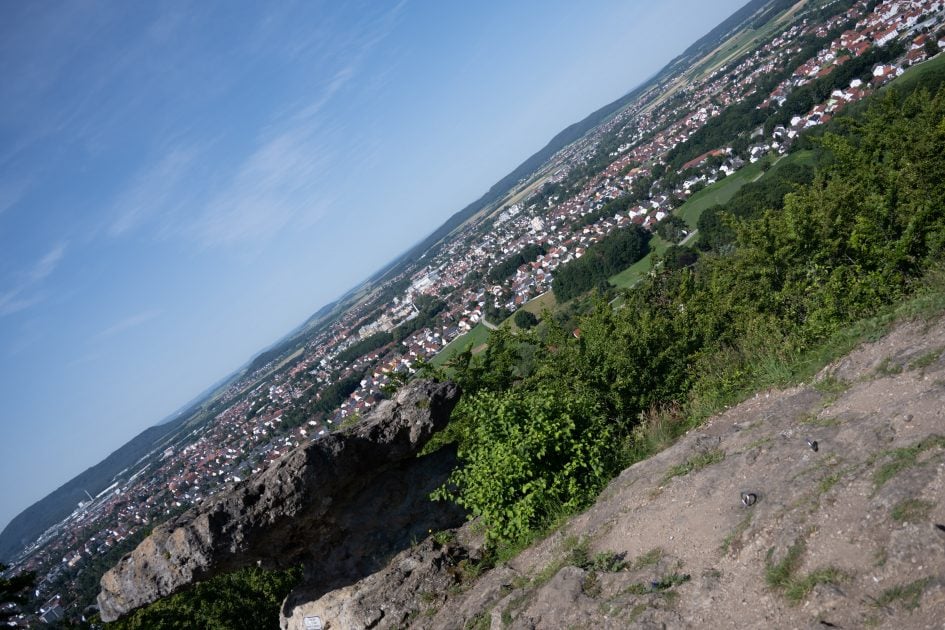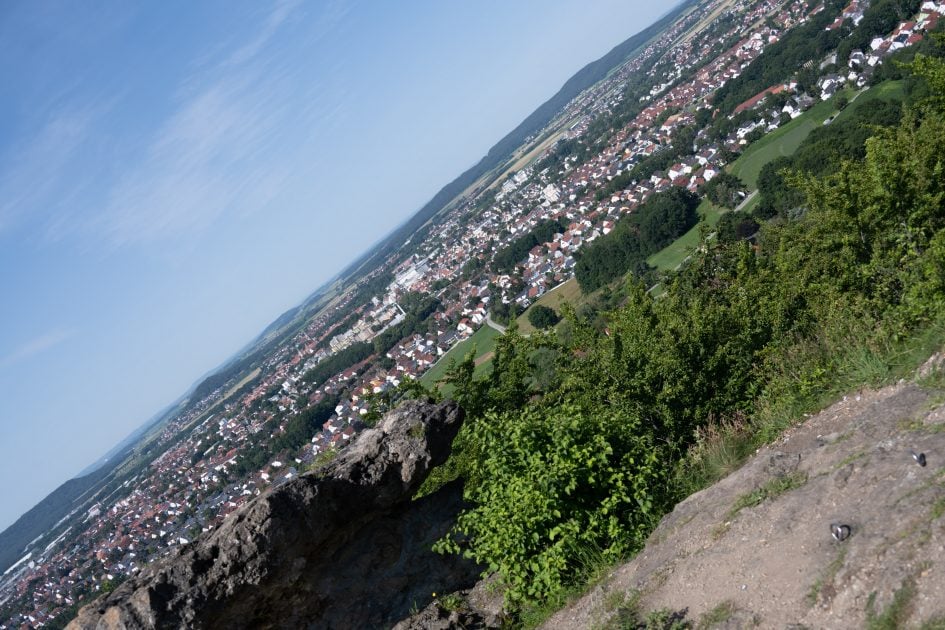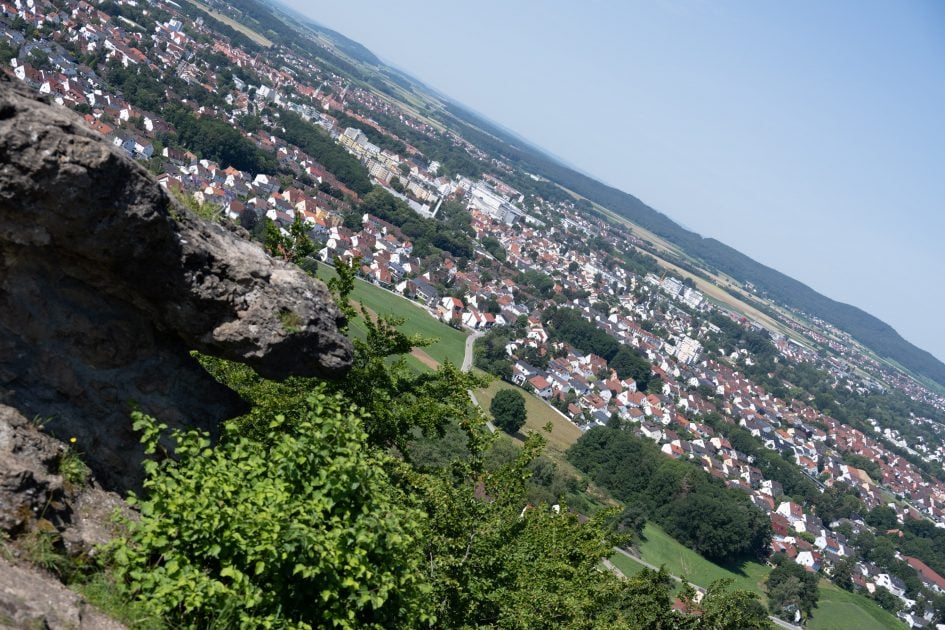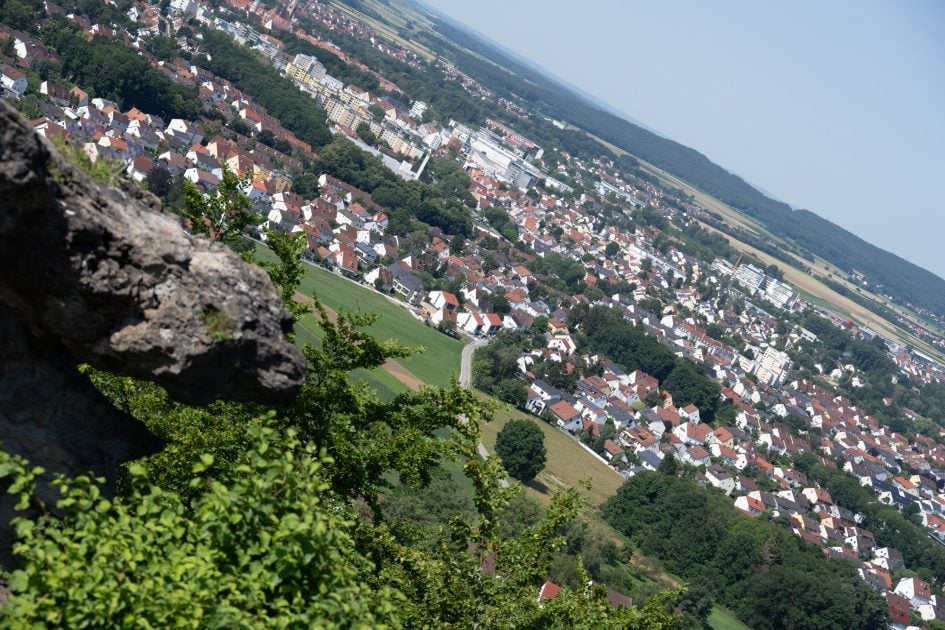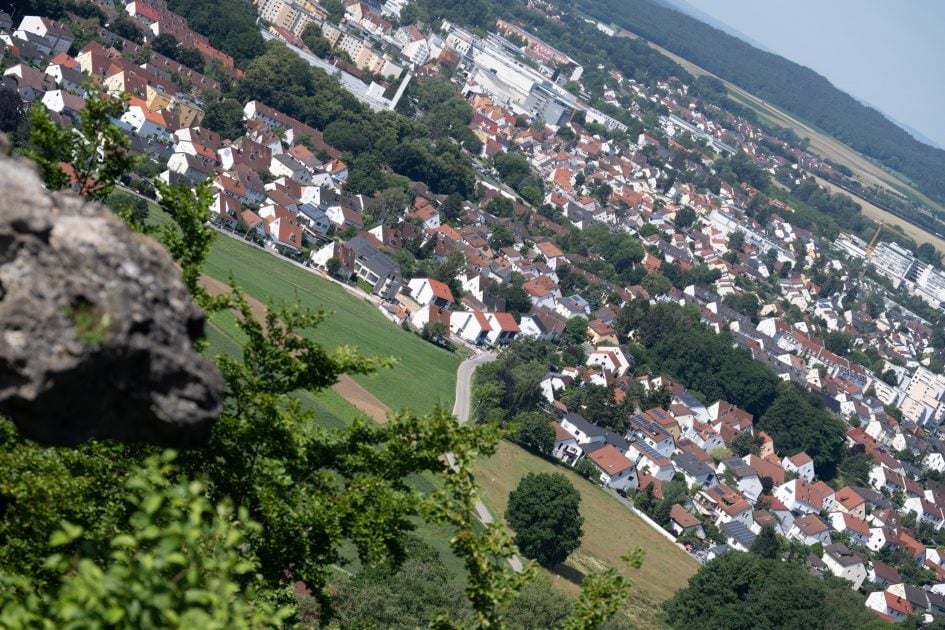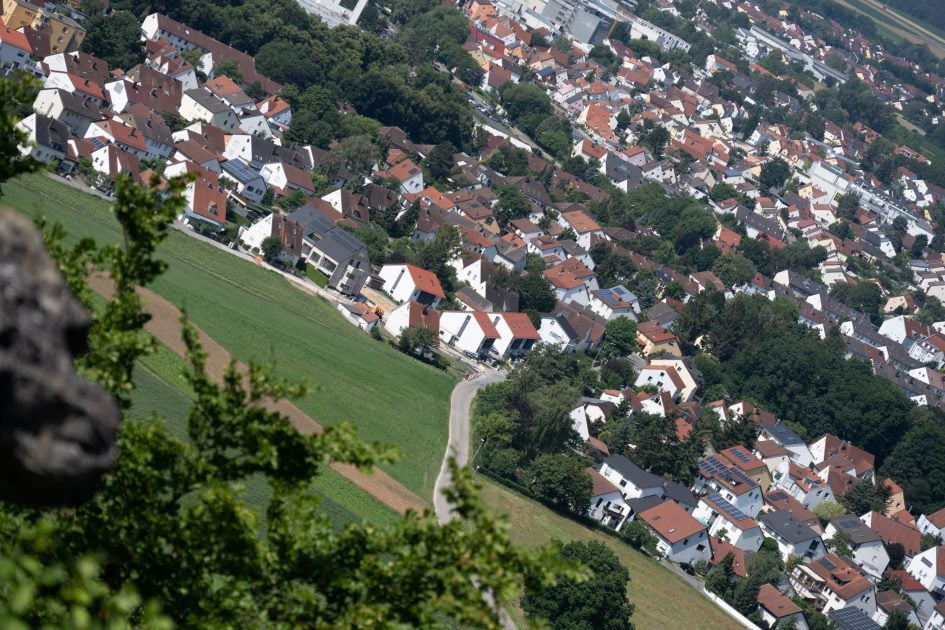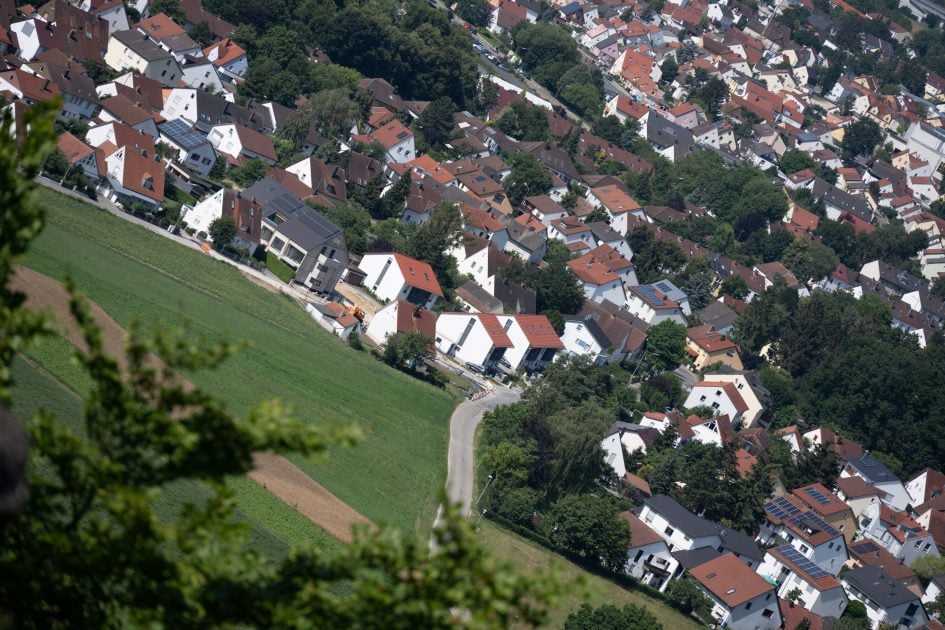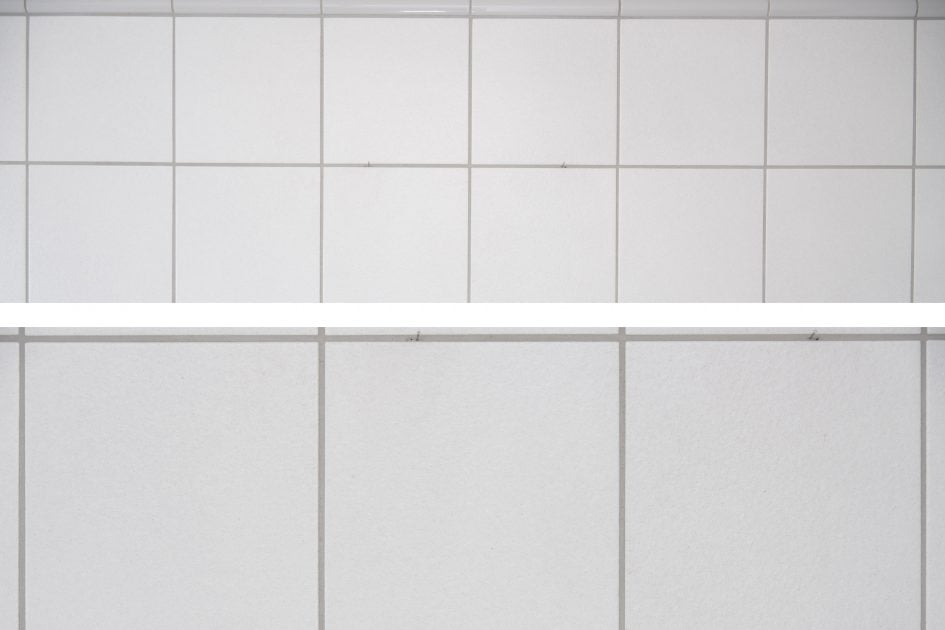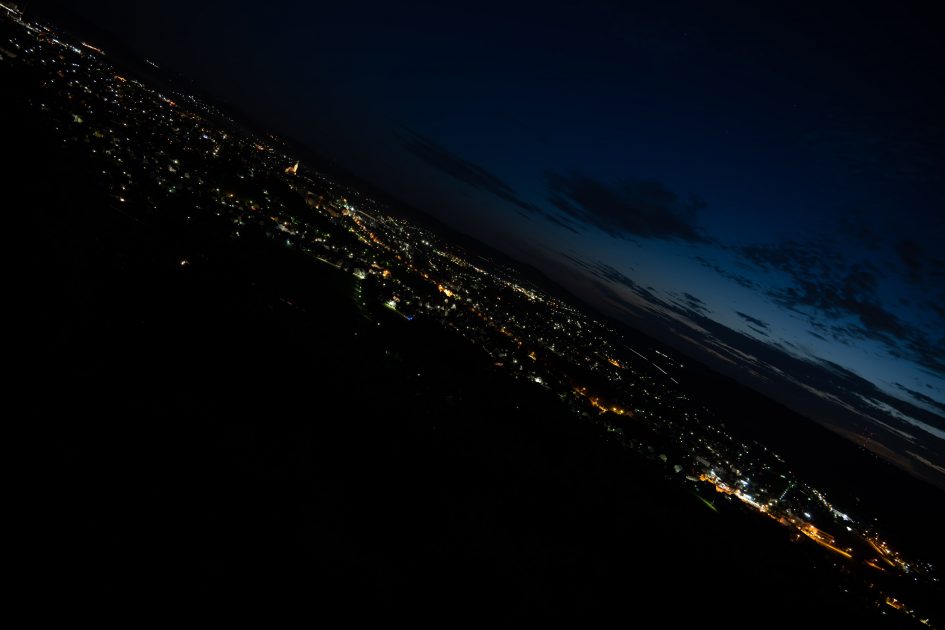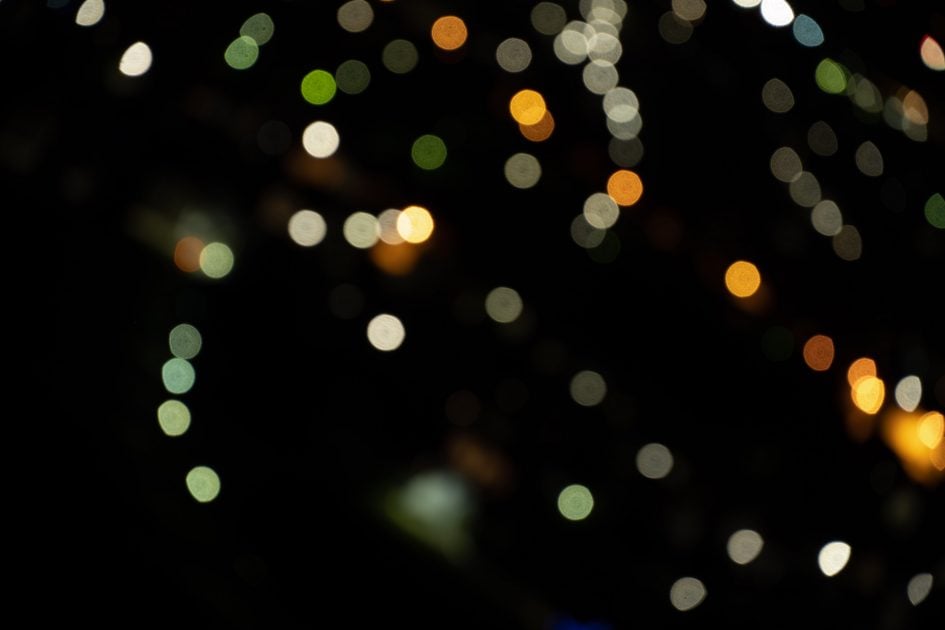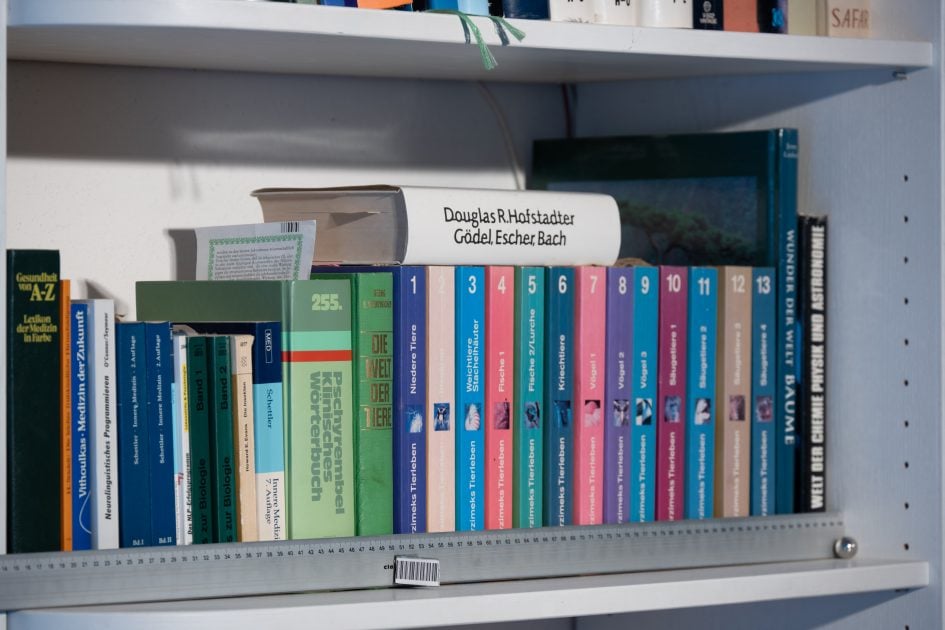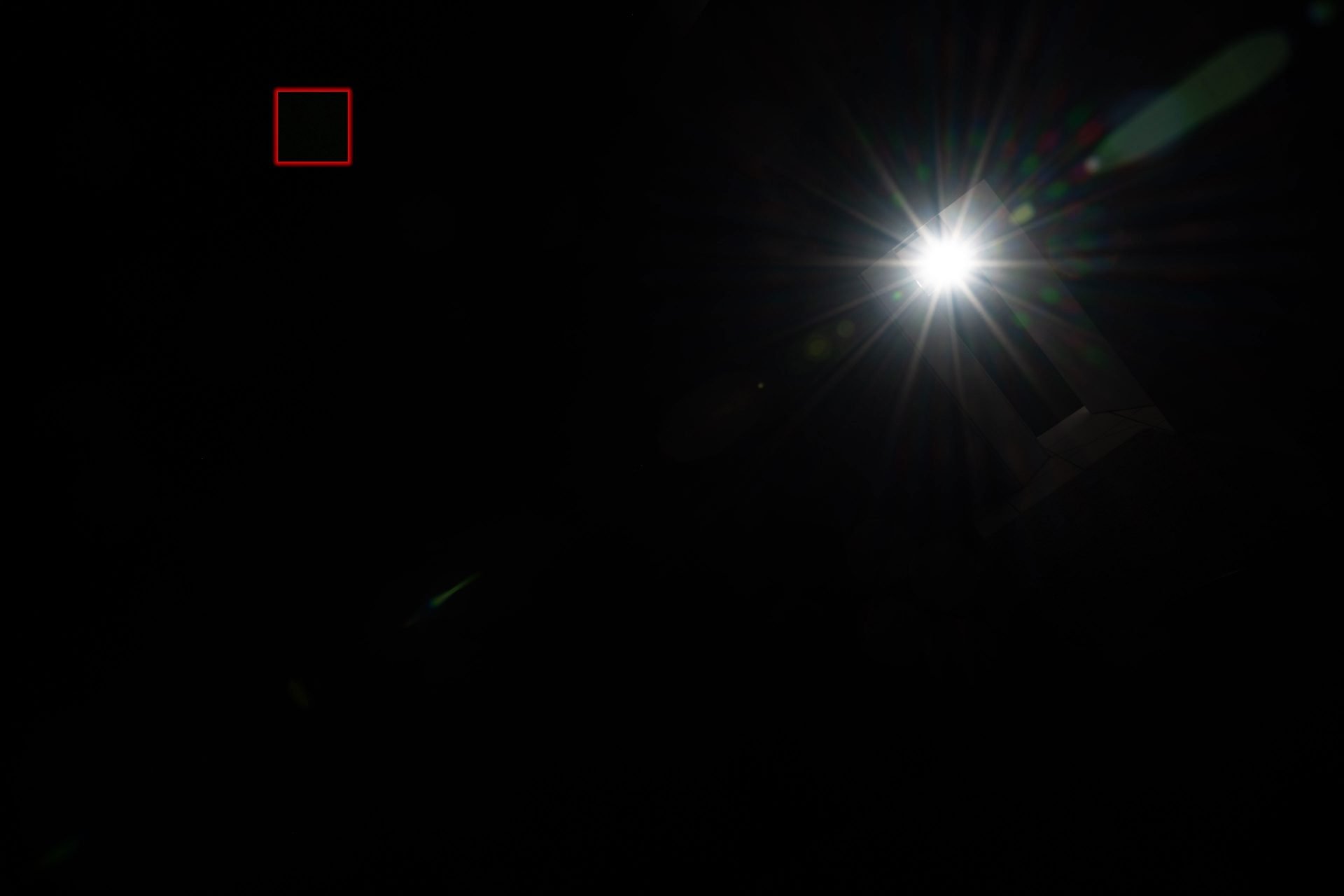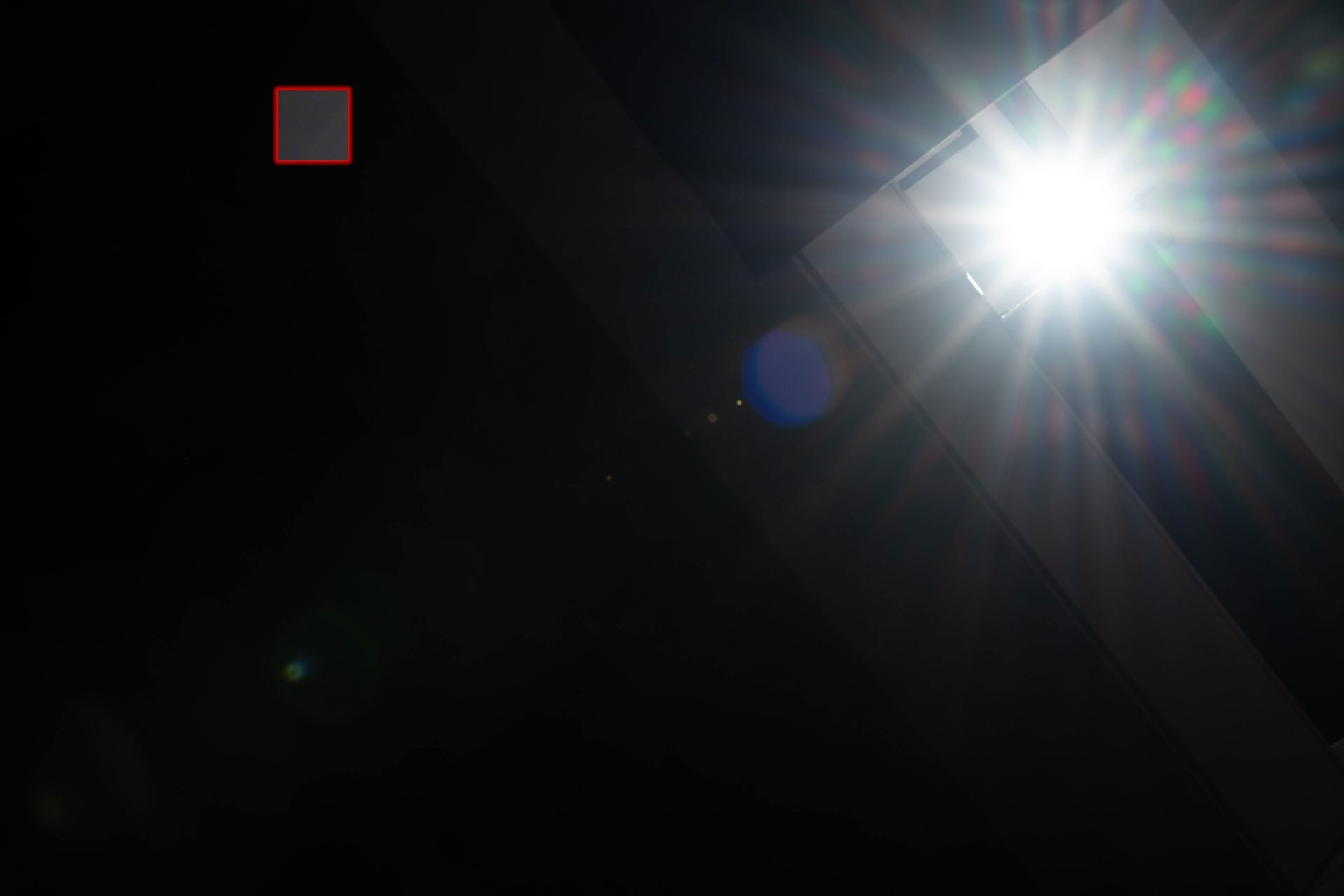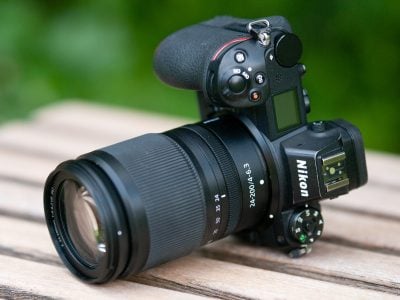Nikon Z 24-200mm f4-6.3 VR review
-
-
Written by Thomas
Quality
Testing: Longitudinal Chromatic Aberration and focus shift
Longitudinal color aberrations (loCA, a.k.a. “axial color” or “bokeh CA”) normally show up as magenta coloration in the foreground and greenish hues in the background and are not easily corrected in post-processing. The new Nikon shows only a faint bit of loCA and there’s also no focus shift to speak of.
Nikon Z 24-200mm f4.0-6.3 VR Longitudinal Chromatic Aberration (loCA)
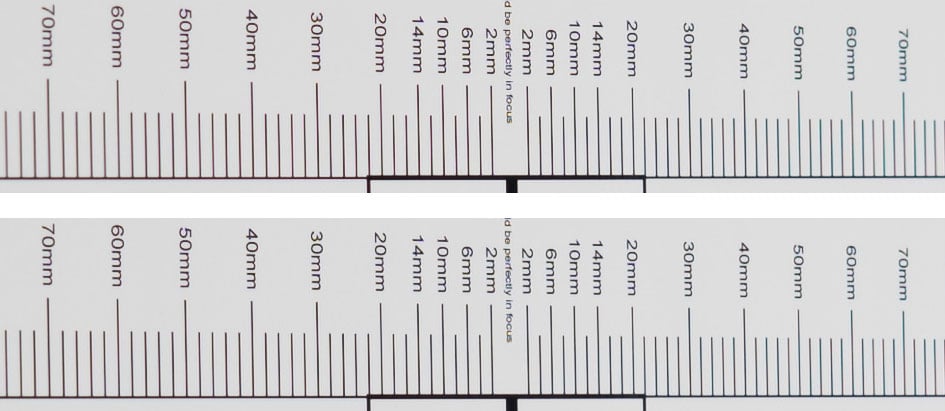
100% crops at 24mm: f4.0 (top), f5.6 (bottom); left = foreground, right = background
The following real life shot shows that the Nikon Z 24-200mm f4.0-6.3 VR produces no purple fringing around high-contrast edges in the focal plane or green outlining around background subjects:
Above: Nikon Z 24-200mm f4.0-6.3 VR at 24mm f4.0, 100% crop, click image for 4k version, here for large original
Sharpness and contrast
Let’s have a look at the theoretical performance of the new Nikon Z 24-200mm f4.0-6.3 VR first and compare it to the performance of the Nikon Z 24-70mm f4.0 S and the Tamron 28-200mm f2.8-5.6 Di III:
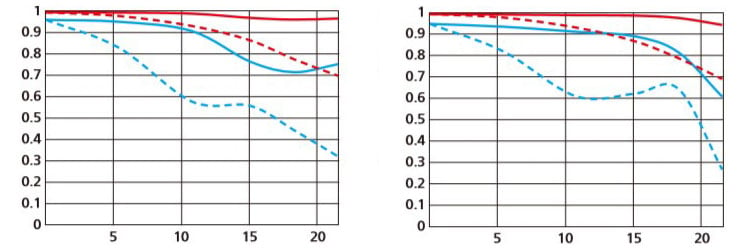
Above: Nikon Z 24-200mm f4.0-6.3 VR, 24mm f4.0 (left), 200mm f6.3 (right)
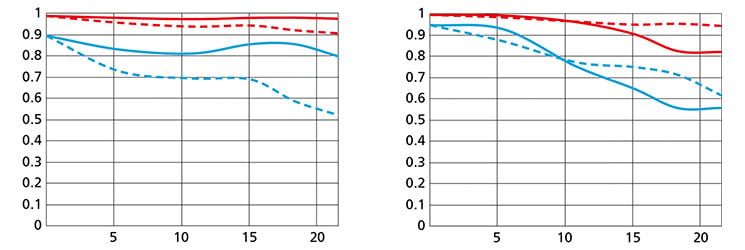
Above: Nikon Z 24-70mm f4.0 S, 24mm f4.0 (left), 70mm f4.0 (right)
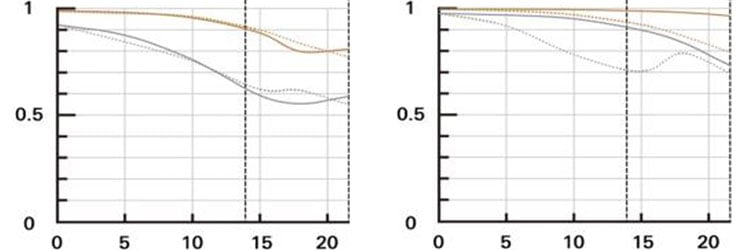
Above: Tamron 28-200mm f2.8-5.6 Di III, 28mm f2.8 (left), 200mm f5.6 (right)
These MTF charts show the computed lens-performance of lenses wide open without influence of diffraction. Higher values are better (more contrast) and the closer the line-pairs are together the less astigmatism (= resolution depends on the orientation of the test-pattern) the lens has. The x-axis displays the distance from the optical axis (=center of the sensor) in mm. I’ll show you the real-life performance at 4 mm (center), 13 mm (DX-C-corner), and 20 mm (FX-corner) on a on a 45MP Nikon Z7 camera (resp. 42MP Sony A7R II camera for the Tamron zoom lens).
From the charts the new Nikon Z 24-200mm f4.0-6.3 VR shows the highest astigmatism of the three lenses with meridional contrast (dotted lines) dropping heavily towards the corners. In the sagittal direction (solid lines) overall contrast and resolution look much better. This may mean that the lens produces fine details quite decently but with a loss of overall contrast towards the corners.
Let’s see how this theoretical performance translates into real life results in the sharpness test based on Siemens-stars. Processing was done in Lightroom 9.3/CRAW 12.3 from RAW to Adobe Color profile with the built-in lens profile for Vignette and Distortion Control plus CA compensation applied. Noise-reduction is set to 0, sharpening to 50/0.5/36/10, with no extra tone, color, or saturation adjustment. White-balance was adjusted to a neutral white and I did some exposure compensation to make the brightness of all crops match. So you will not see light fall-off in the corners.
The following are all 100% crops!
First up is an overview of the wide-open performance at different focal lengths. You can jump to the detailed results at different apertures and comparisons with the alternatives by clicking on the crops of the respective focal length.
Nikon Z 24-200mm f4.0-6.3 VR; 100% crop from center, DX-corner, FX-corner
Above: 24mm, f4.0
Above: 28mm, f4.2
Above: 35mm, f4.8
Above: 50mm, f5.6
Above: 70mm, f6.0
Above: 105mm, f6.3
Above: 150mm, f6.3
Above: 200mm, f6.3
Nikon’s new zoom lens performs pretty well within the DX image-circle: The center is sharp to very sharp at the wide end softening a little bit towards longer focal lengths. The DX-corner starts a bit soft at 24mm but is pretty sharp between 28mm and 105mm focal length. At the long end it loses some detail. The FX-corner is quite sharp at 50mm but outright mushy at 24mm and 105mm focal length. Btw.: The lens exhibits only little field curvature over its zoom range. Overall performance is not too bad considering the 8.3 zoom-range.
If you want to see all the details and comparisons with other lenses, read on. Or you can fast-forward to the performance at long distances.
The following 100% crops for each focal length show the new Nikon Z 24-200mm f4.0-6.3 VR from wide open down to f11 compared to the Nikon Z 24-70mm f4.0 S and Tamron 28-200mm f2.8-5.6 Di III. The Tamron was shot on a 42MP Sony A7R II which has a 4% lower linear resolution. But you can still get a good picture of how the Tamron performs in comparison.
Performance at 24mm:
Nikon Z 24-200mm f4.0-6.3 VR at 24mm; 100% crop from center, DX-corner, FX-corner

Above: Nikon Z 24-200mm f4.0-6.3 VR at 24mm, f4.0

Above: Nikon Z 24-70mm f4.0 S at 24mm, f4.0

Above: Nikon Z 24-200mm f4.0-6.3 VR at 24mm, f5.6

Above: Nikon Z 24-200mm f4.0-6.3 VR at 24mm, f8.0

Above: Nikon Z 24-200mm f4.0-6.3 VR at 24mm, f11
At 24mm focal length the new Nikon Z 24-200mm f4.0-6.3 VR is sharper in the center but softer in the DX-corner than the Nikon Z 24-70mm f4.0 S. The FX-corner is pretty soft with both lenses. Stopping down lifts the FX-corner a bit but perhaps not as much as one could have wished for.
Performance at 28mm:
Nikon Z 24-200mm f4.0-6.3 VR at 28mm; 100% crop from center, DX-corner, FX-corner

Above: Nikon Z 24-200mm f4.0-6.3 VR at 28mm, f4.2

Above: Nikon Z 24-70mm f4.0 S at 28mm, f4.0

Above: Tamron 28-200mm f2.8-5.6 Di III on a Sony A7R II at 28mm, f4.0

Above: Nikon Z 24-200mm f4.0-6.3 VR at 28mm, f5.6

Above: Nikon Z 24-200mm f4.0-6.3 VR at 28mm, f8.0

Above: Nikon Z 24-200mm f4.0-6.3 VR at 28mm, f11
At 28mm focal length the new Nikon Z 24-200mm is slightly sharper in the center than the Nikon Z 24-70mm f4.0 S. But the Tamron 28-200mm f2.8-5.6 Di III looks like the winner here.
Performance at 35mm:
Nikon Z 24-200mm f4.0-6.3 VR at 35mm; 100% crop from center, DX-corner, FX-corner

Above: Nikon Z 24-200mm f4.0-6.3 VR at 35mm, f4.8

Above: Nikon Z 24-70mm f4.0 S at 35mm, f4.0

Above: Tamron 28-200mm f2.8-5.6 Di III on a Sony A7R II at 35mm, f4.0

Above: Nikon Z 24-200mm f4.0-6.3 VR at 35mm, f5.6

Above: Nikon Z 24-200mm f4.0-6.3 VR at 35mm, f8.0

Above: Nikon Z 24-200mm f4.0-6.3 VR at 35mm, f11
Within the DX image-circle all three lenses look pretty similar with the Nikon Z 24-70mm f4.0 S showing a slightly softer center than the other two. The FX-corner again is sharpest from the Tamron 28-200mm.
Performance at 50mm:
Nikon Z 24-200mm f4.0-6.3 VR at 50mm; 100% crop from center, DX-corner, FX-corner

Above: Nikon Z 24-200mm f4.0-6.3 VR at 50mm, f5.6

Above: Nikon Z 24-70mm f4.0 S at 50mm, f5.6

Above: Tamron 28-200mm f2.8-5.6 Di III on a Sony A7R II at 50mm, f5.6

Above: Nikon Z 24-200mm f4.0-6.3 VR at 50mm, f8.0

Above: Nikon Z 24-200mm f4.0-6.3 VR at 50mm, f11
At 50mm focal length the three lenses are very close across the full-frame image circle with the new Nikon Z 24-200mm just a little bit softer than the Nikon Z 24-70mm f4.0 S and the Tamron 28-200mm again producing the sharpest FX-corner.
Performance at 70mm:
Nikon Z 24-200mm f4.0-6.3 VR at 70mm; 100% crop from center, DX-corner, FX-corner

Above: Nikon Z 24-200mm f4.0-6.3 VR at 70mm, f6.0

Above: Nikon Z 24-70mm f4.0 S at 70mm, f5.6

Above: Tamron 28-200mm f2.8-5.6 Di III on a Sony A7R II at 70mm, f5.6

Above: Nikon Z 24-200mm f4.0-6.3 VR at 70mm, f8.0

Above: Nikon Z 24-200mm f4.0-6.3 VR at 70mm, f11
At 70mm the new Nikon Z 24-200mm suffers a bit from its softer FX-corner. Even stopping down to f8.0 or f11 does not lift the FX-corner to the sharpness of the Tamron.
Performance at 105mm:
Nikon Z 24-200mm f4.0-6.3 VR at 105mm; 100% crop from center, DX-corner, FX-corner

Above: Nikon Z 24-200mm f4.0-6.3 VR at 105mm, f6.3

Above: Tamron 28-200mm f2.8-5.6 Di III on a Sony A7R II at 105mm, f5.6

Above: Nikon Z 24-200mm f4.0-6.3 VR at 105mm, f8.0

Above: Nikon Z 24-200mm f4.0-6.3 VR at 105mm, f11
In the DX image-circle the new Nikon Z 24-200mm looks very similar to the Tamron 28-200mm. But the latter again wins at the FX-corner – by a huge margin. Unfortunately the FX-corner of the Nikon does not respond well to stopping down.
Performance at 150mm:
Nikon Z 24-200mm f4.0-6.3 VR at 150mm; 100% crop from center, DX-corner, FX-corner

Above: Nikon Z 24-200mm f4.0-6.3 VR at 150mm, f6.3

Above: Tamron 28-200mm f2.8-5.6 Di III on a Sony A7R II at 150mm, f5.6

Above: Nikon Z 24-200mm f4.0-6.3 VR at 150mm, f8.0

Above: Nikon Z 24-200mm f4.0-6.3 VR at 150mm, f11
At 150mm focal length the new Nikon Z 24-200mm is clearly softer than the Tamron 28-200mm – even stopped down to f8.0.
Performance at 200mm:
Nikon Z 24-200mm f4.0-6.3 VR at 200mm; 100% crop from center, DX-corner, FX-corner

Above: Nikon Z 24-200mm f4.0-6.3 VR at 200mm, f6.3

Above: Tamron 28-200mm f2.8-5.6 Di III on a Sony A7R II at 200mm, f5.6

Above: Nikon Z 24-200mm f4.0-6.3 VR at 200mm, f8.0

Above: Nikon Z 24-200mm f4.0-6.3 VR at 200mm, f11
Same as before, although the difference is not as big as at 150mm.
Overall Nikon’s new Z 24-200mm zoom lens performs quit satisfyingly in this test – if you don’t look to close into the extreme corners of a full-frame sensor. Where their respective zoom-range overlaps the Z 24-200mm f4.0-6.3 VR and the Z 24-70mm f4.0 S are very close with the super-zoom even producing a slightly sharper center. But the real surprise in this comparison is the Tamron 28-200mm f2.8-5.6 Di III which outperformed both Nikon zoom lenses at every focal length.
Performance at long distances
The Siemens-star test-targets are shot at a distance of 45x focal length (i.e. at around 3m for 70mm focal length). But performance of lenses also depends on the shooting distance. Therefore I present another series of test-shots of a city around 1 km away. Processing was done in Lightroom 9.2/CRAW 12.2 from RAW to Adobe Color profile with the built-in lens profile compensating CA and vignetting. Noise-reduction is set to 0, sharpening to 50/0.5/36/10, with no extra tone, color, or saturation adjustment. I used manual focus at the largest aperture and did not change focus for other apertures. All shots were made at ISO 100 and image stabilization switched off.
Following is an overview of the wide-open performance at different focal lengths. You can jump to the detailed results at different apertures and comparisons with the Tamron 70-180mm f2.8 Di III by clicking on the crops of the respective focal length. As usual I have selected the diagonal that provided the better corner results as almost any lens is a bit decentered.
Nikon Z 24-200mm f4.0-6.3 VR; 100% crop from center, DX-corner, FX-corner
Above: 24mm, f4.0
Above: 28mm, f4.2
Above: 35mm, f4.8
Above: 50mm, f5.6
Above: 70mm, f6.0
Above: 105mm, f6.3
Above: 150mm, f6.3
Above: 200mm, f6.3
In this long-distance test Nikon’s new zoom lens looks quite capable. The FX-corner is certainly not the sharpest but does not look quite as soft as in the preceding test. The center looks good across the zoom-range, and the DX-corner shows some blue fringing at high-contrast edges at 24mm and 28mm focal length but otherwise delivers nice details.
If you want to see all the details and comparisons with other lenses, read on. Or fast-forward to the next chapter on vignetting and distortions.
The main image shows the complete scene wide open to give you an impression of the angle of view and to judge vignetting. Following the main image are 100% crops from the center, DX-corner, and FX-corner for each focal length from the Nikon Z 24-200mm f4.0-6.3 VR down to f11. For comparison I use the Tamron 28-200mm f2.8-5.6 Di III shot only minutes apart and the Nikon Z 24-70mm f4.0 S shot another day.
You can access the large originals but please respect our copyright and only use those images for personal use.
Results at 24mm:
Above: Nikon Z 24-200mm f4.0-6.3 VR at 24mm, f4.0
Above: Nikon Z 24-200mm f4.0-6.3 VR at 24mm, f4.0; 100% crops, click image for 4k version, here for large original
Above: Nikon Z 24-70mm f4.0 S at 24mm, f4.0; 100% crops, click image for 4k version, here for large original

Above: Nikon Z 24-200mm f4.0-6.3 VR at 24mm, f5.6

Above: Nikon Z 24-200mm f4.0-6.3 VR at 24mm, f8.0

Above: Nikon Z 24-200mm f4.0-6.3 VR at 24mm, f11
In comparison to the Nikon Z 24-70mm f4.0 S the Nikon Z 24-200mm f4.0-6.3 VR looks a bit softer outside the center.
Results at 28mm:
Above: Nikon Z 24-200mm f4.0-6.3 VR at 28mm, f4.2
Above: Nikon Z 24-200mm f4.0-6.3 VR at 28mm, f4.2; 100% crops, click image for 4k version, here for large original
Above: Nikon Z 24-70mm f4.0 S at 28mm, f4.0; 100% crops, click image for 4k version, here for large original
Above: Tamron 28-200mm f2.8-5.6 Di III at 28mm, f4.0, shot on a Sony A7R II; 100% crops, click image for 4k version, here for large original

Above: Nikon Z 24-200mm f4.0-6.3 VR at 28mm, f5.6

Above: Nikon Z 24-200mm f4.0-6.3 VR at 28mm, f8.0

Above: Nikon Z 24-200mm f4.0-6.3 VR at 28mm, f11
At 28mm the Nikon Z 24-70mm f4.0 S is the sharpest of the three lenses across the full-frame sensor. The Tamron 28-200mm f2.8-5.6 Di III ekes out a small advantage in the FX-corner over the Nikon Z 24-200mm f4.0-6.3 VR but other than that the differences between those two lenses are minimal.
Results at 35mm:
Above: Nikon Z 24-200mm f4.0-6.3 VR at 35mm, f4.8
Above: Nikon Z 24-200mm f4.0-6.3 VR at 35mm, f4.8; 100% crops, click image for 4k version, here for large original
Above: Nikon Z 24-70mm f4.0 S at 35mm, f4.0; 100% crops, click image for 4k version, here for large original
Above: Tamron 28-200mm f2.8-5.6 Di III at 35mm, f4.0, shot on a Sony A7R II; 100% crops, click image for 4k version, here for large original

Above: Nikon Z 24-200mm f4.0-6.3 VR at 35mm, f5.6

Above: Nikon Z 24-200mm f4.0-6.3 VR at 35mm, f8.0

Above: Nikon Z 24-200mm f4.0-6.3 VR at 35mm, f11
Again the Nikon Z 24-70mm f4.0 S looks best across the full-frame sensor. The Nikon Z 24-200mm and the Tamron 28-200mm perform very similar in the DX image-circle but look softer in the FX-corner with a slight advantage for the Nikon Z 24-200mm over the Tamron.
Results at 50mm:
Above: Nikon Z 24-200mm f4.0-6.3 VR at 50mm, f5.6
Above: Nikon Z 24-200mm f4.0-6.3 VR at 50mm, f5.6; 100% crops, click image for 4k version, here for large original
Above: Nikon Z 24-70mm f4.0 S at 50mm, f5.6; 100% crops, click image for 4k version, here for large original
Above: Tamron 28-200mm f2.8-5.6 Di III at 50mm, f5.6, shot on a Sony A7R II; 100% crops, click image for 4k version, here for large original

Above: Nikon Z 24-200mm f4.0-6.3 VR at 50mm, f8.0

Above: Nikon Z 24-200mm f4.0-6.3 VR at 50mm, f11
At 50mm center sharpness looks good at all three lenses, the DX-corner is a bit soft from the Tamron and the FX-corner is softest from the Nikon Z 24-200mm.
Results at 70mm:
Above: Nikon Z 24-200mm f4.0-6.3 VR at 70mm, f6.0
Above: Nikon Z 24-200mm f4.0-6.3 VR at 70mm, f6.0; 100% crops, click image for 4k version, here for large original
Above: Nikon Z 24-70mm f4.0 S at 70mm, f5.6; 100% crops, click image for 4k version, here for large original
Above: Tamron 28-200mm f2.8-5.6 Di III at 70mm, f5.6, shot on a Sony A7R II; 100% crops, click image for 4k version, here for large original

Above: Nikon Z 24-200mm f4.0-6.3 VR at 70mm, f8.0

Above: Nikon Z 24-200mm f4.0-6.3 VR at 70mm, f11
All three lenses look pretty close at 70mm focal length with the Tamron seeming to have a slight advantage outside the center.
Results at 105mm:
Above: Nikon Z 24-200mm f4.0-6.3 VR at 105mm, f6.3
Above: Nikon Z 24-200mm f4.0-6.3 VR at 105mm, f6.3; 100% crops, click image for 4k version, here for large original
Above: Tamron 28-200mm f2.8-5.6 Di III at 105mm, f5.6, shot on a Sony A7R II; 100% crops, click image for 4k version, here for large original

Above: Nikon Z 24-200mm f4.0-6.3 VR at 105mm, f8.0

Above: Nikon Z 24-200mm f4.0-6.3 VR at 105mm, f11
At 105mm the Nikon Z 24-200mm and Tamron 28-200mm again are very close with the Nikon displaying the slightly sharper DX-corner, the Tamron the slightly sharper FX-corner.
Results at 150mm:
Above: Nikon Z 24-200mm f4.0-6.3 VR at 150mm, f6.3
Above: Nikon Z 24-200mm f4.0-6.3 VR at 150mm, f6.3; 100% crops, click image for 4k version, here for large original
Above: Tamron 28-200mm f2.8-5.6 Di III at 150mm, f5.6, shot on a Sony A7R II; 100% crops, click image for 4k version, here for large original

Above: Nikon Z 24-200mm f4.0-6.3 VR at 150mm, f8.0

Above: Nikon Z 24-200mm f4.0-6.3 VR at 150mm, f11
Both lenses perform very close at 150 focal length.
Results at 200mm:
Above: Nikon Z 24-200mm f4.0-6.3 VR at 200mm, f6.3
Above: Nikon Z 24-200mm f4.0-6.3 VR at 200mm, f6.3; 100% crops, click image for 4k version, here for large original
Above: Tamron 28-200mm f2.8-5.6 Di III at 200mm, f5.6, shot on a Sony A7R II; 100% crops, click image for 4k version, here for large original

Above: Nikon Z 24-200mm f4.0-6.3 VR at 200mm, f8.0

Above: Nikon Z 24-200mm f4.0-6.3 VR at 200mm, f11
Again very close with the Tamron 28-200mm having the slightly sharper FX-corner.
The new Nikon Z 24-200mm f4.0-6.3 VR performed very well in this long-distance test although up to 50mm focal length the Nikon Z 24-70mm f4.0 S is sharper right up into the extreme corners of a full-frame sensor. The Tamron 28-200mm f2.8-5.6 Di III again fared very well too but was more neck-and-neck with Nikon’s 24-200mm zoom lens than in the close-distance test.
Vignetting and distortions
To make it easier to see light fall-off in the corners of a full-frame sensor I’ve arranged a series of three shots each with the new Z-Nikkor from f4.0 to f8.0 at 24mm and f5.6-f11 at 200mm focal length. All images were developed to the same brightness in the center and with the built-in lens profile compensating vignetting set to “normal”:
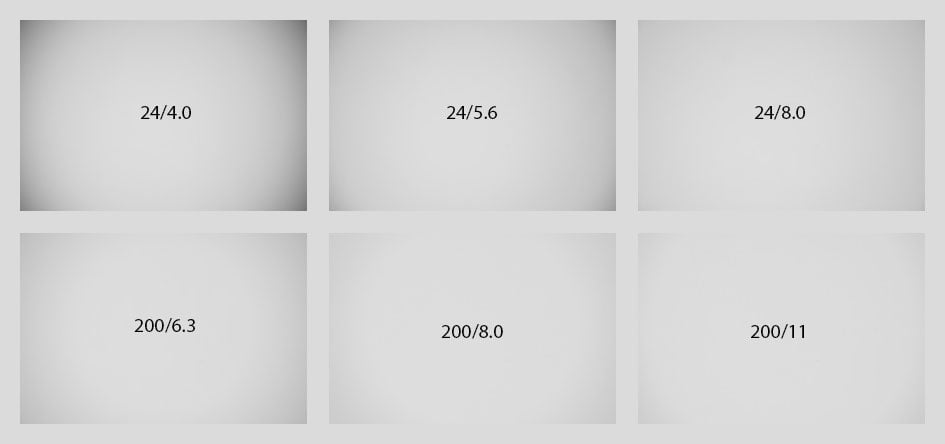
Above: Nikon Z 24-200mm f4.0-6.3 VR at 24mm and 200mm focal length
The sample images above show that even with the lens profile applied vignetting is not completely eliminated. But on the long end it’s pretty inconspicuous. At 24mm f4.0 automatic shading compensation lifts the extreme corners about 0.3 EV which is pretty little. I didn’t test Vignette control at “high” which should give the corners a stronger lift. Adobe’s RAW converter automatically applies Vignette control as it was set in camera – but you cannot alter the setting in postprocessing.
The setting for distortion control cannot be switched off in camera nor in Nikon’s Capture NX-D or in Adobe’s Lightroom 9.3 / CRAW 12.3. At least the lens profile does a pretty good job to correct for distortions:
Distortions: Nikon Z 24-200mm f4.0-6.3 VR at 24mm (top), 70mm (bottom), with Distortion Control ON
Rendering of point-light sources at night-shots
Night-shots pose a different challenge for lenses as the contrast is even higher than under bright sun and point-light sources can reveal some weaknesses such as coma, haloing and colour-aberrations that do not show up as prominently in other test-shots. The 100% crop below the main image show the effects at the center and in the FX-corner of the new Nikon compared to the Tamron 28-200mm f2.8-5.6 Di III:
Above: Nikon Z 24-200mm f4.0-6.3 VR at 24mm, f4.0
Above: Nikon Z 24-200mm f4.0-6.3 VR at 24mm f4.0; 100% crops from the center (left) and FF-corner (right); click image for 4k version, here for large original
Above: Tamron 28-200mm f2.8-5.6 Di III at 28mm f2.8; 100% crops from the center (left) and FF-corner (right); click image for 4k version, here for large original
The Nikon shows almost no coma in the corner while the Tamron shows the typical coma signature. But then the Tamron is at f2.8 here while the Nikon is at f4.0. Coloration around point-light sources in the center is minimal with both lenses.
Rendering of out-of-focus point-light sources
This test is for the rendering of point-light sources in an out-of-focus background. The circle of confusion that is produced by this test is pretty indicative of Bokeh performance (in the background) and light fall-off. Ideally the out-of-focus image of the point-light is evenly lit and perfectly circular, with no “onion-rings”, and without coloration. There’s also an effect known as “cat’s eye” the further away from the optical axis the point-light is projected. This is due to optical vignetting in the lens barrel when light enters the lens from an angle.
All images were shot at the longest focal length and largest aperture. The new Nikon is first followed by the Tamron 28-200mm f2.8-5.6 Di III. Crops are from the center, DX-corner, and FX-corner resized to make them comparable across all my reviews.
Above: Nikon Z 24-200mm f4.0-6.3 VR at 200mm, f6.3
Above: Nikon Z 24-200mm f4.0-6.3 VR at 200mm, f6.3; click image for 4k version
Above: Tamron 28-200mm f2.8-5.6 Di III at 200mm, f5.6; click image for 4k version
The Nikon has a slightly smaller entrance pupil than the Tamron so it should produce 10% smaller Bokeh balls. This is not reflected in this test as I could not match magnification of both lenses perfectly. Regarding onion rings: The Nikon has the smoother interior than the Tamron which shows some rings – and also stronger outlining than the Nikon. Looking towards the corners both lenses develop a similar degree of cat’s eye effect in the FF-corner. And compression is quite visible already at the APS-C-corner – where the Nikon has the benefit of a slightly fuller circle.
Now let’s see how this analysis of out-of-focus point-light sources translates into Bokeh-performance shooting a book-shelf. Crops are from the foreground, middle-ground, and background resized to make them comparable across all my reviews. I used the longest focal length that I could to produce a comparable shot to my other reviews which was in the case of the new Nikon 165mm. The Tamron had to be zoomed in to 162mm to achieve the same magnification from the same distance:
Above: Nikon Z 24-200mm f4.0-6.3 VR at 165mm, f6.3
Above: Nikon Z 24-200mm f4.0-6.3 VR at 165mm, f6.3; click image for 4k version, here for large original
Above: Tamron 28-200mm f2.8-5.6 Di III at 162mm, f5.6; click image for 4k version, here for large original
Above: Tamron 70-180mm f2.8 Di III at 165mm, f2.8; click image for 4k version, here for large original
As was to be expected from the night shots both super-zooms have a pretty similar background Bokeh. Looking close, the Tamron seems a tad more nervous than the Nikon. The real eye-opener in this comparison are the last crops from the Tamron 70-180mm f2.8 Di III at 165mm f2.8: It clearly shows how much more blur you can produce with a larger aperture lens.
Close-up performance
The new Nikon goes down to 1:3.4 magnification at 200mm focal length. The following images were shot at 1:3.5 magnification where the area of sharp focus is just 126 x 84mm. The crops shown below are from 0mm, 12mm, and 18mm off the center of the sensor respectively:

Above: Nikon Z 24-200mm f4.0-6.3 VR at 200mm, f6.3; 100% crops

Above: Nikon Z 24-200mm f4.0-6.3 VR at 200mm, f8; 100% crops

Above: Nikon Z 24-200mm f4.0-6.3 VR at 200mm, f11; 100% crops
The Nikon Z 24-200mm f4.0-6.3 VR produces very good results in the center at f8. But for a larger area of good sharpness you need to stop down to f11.
Flare, ghosting, and sun-stars
Catching a strong light-source shining directly into the lens is always a risky business: it could produce strange colorful ghost-images or reduce contrast considerably through flare and glare. The appearance of flare and ghosting depends on factors like the aperture and the angle of the light hitting the lens. So to judge the proclivity of the new Nikon Z 24-200mm f4.0-6.3 VR for these artifacts I went through a series of well calculated shots against a strong light source to provoke glare and ghosting.
At 24mm focal length the new Nikon Z 24-200mm f4.0-6.3 VR is pretty resilient against contra light and keeps a very good overall contrast with little veiling glare. At 70mm reflexes and veiling glare become more prominent:
Above: Strong light hitting the Nikon Z 24-200mm f4.0-6.3 VR at 24mm, f11; click image for 4k version or here for +3 EV exposure compensation
Above: Strong light hitting the Nikon Z 24-200mm f4.0-6.3 VR at 70mm, f11; click image for 4k version or here for +3 EV exposure compensation
The little bright square inset in the upper left of both images shows the respective area with an exposure compensation of +3 EV to make it easier to see which levels of black the lens renders at that point. What you can also see in the images above: The new Nikon Z 24-200mm f4.0-6.3 VR does not produce well defined sunstars at f11.
Next check out my sample images!
Check prices on the Nikon Z 24-200mm at B&H, Adorama or WEX! Alternatively get yourself a copy of my In Camera book or treat me to a coffee! Thanks!








